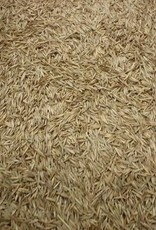| Article number: |
48465242 |
| Availability: |
Out of stock |
| Delivery time: |
Please contact us for delivery timeframe |
Orders placed online for this product will not be processed without obtaining a shipping quote beforehand.
Item # 48465242
Product Description:
Creeping Red Fescue grass seed is widely planted for turf grass in the transition and northern cool season areas. ... Its major use is for dry shaded areas as either a pure stand or as a mixture in other grass seed mixtures such as Bluegrass seed, Creeping Bent grass seed and Perennial Ryegrass seed. Creeping Red Fescue grass will survive in areas of heavy shade (2-4 hours of daily sun) and has a low to moderate tolerance for traffic.
Creeping Red Fescue seed can also be used to overseed warm-season turfs such as Bermuda grass. It grows best in well drained sites and in drought, infertile soils. It does not tolerate wet soils or high fertilization rates, including highly fertile soils. -- Pernille, Evergreen, & Boreal are the more common varieties.
There are two different types of creeping red fescue - Rubra rubra and Rubra trichophylla. The Rubra rubra variety is called a "strong creeping" type with 56 chromosomes compared to 42 in the other type. These varieties of creeping red fescue both spread via rhizomes(underground creeping stems) and stolons (above ground creeping stems) which allow them to spread and repair turf areas. The Rubra trichophylla variety produces shorter rhizomes that repair at a slower rate than the Rubra rubra. For the common Creeping Red we generally sell the Boreal, Evergreen, or Pernille seed varieties which are the Rubra rubra varieties.
Creeping Red Fescue is used extensively in all types of turf areas including:
• airfields
• athletic fields
• cemeteries
• fairways
• golf courses
• home lawns
• landscape areas
• parks
• playgrounds
• roadsides
Advantages:
♦ Great for seeding under trees.
♦ Excellent companion grass
♦ Creates excellent permanent turf that thrives in shady areas
♦ High tolerance for cold temperatures and moderate tolerance for drought and wear
♦ Dark green year-round
♦ Fully tested, ready to plant
When is the best time to plant fescue grass seed?
Fall is the best time to plant fescue and other cool season grass. Planting in the fall presents the least risk of planting failure for cool season grass. Plant your cool season grass seed when the fall temperatures reach 75° and are dropping as winter approaches. By planting during these optimal seasons of cool temperatures and strong growth, you also take advantage of fall and spring rains.
How do you plant creeping red fescue seed?
Plant 1/8 inch (3 ml.) deep and keep mowed at 3-4 inches (7.5-10 cm.) high. While red fescue will grow fine on its own, it does much better when mixed with other grass seeds.
Will grass seed grow if you just throw it on the ground?
The grass seed will sprout and grow. The first thing that needs to be discovered is the pH of the soil. For grass to thrive the pH of the soil needs to be a certain pH. ... If the seed is just thrown on the ground it will cause poor germination.
Establishment of Red Fescue Grass Seed:
New Lawns: 3-5 lbs. per 1000 sq. ft.
Over-seeding: 4 lbs. per 1000 sq. ft. Planting Depth: 1/8 to 1/4”; with germination in 7- 21 days.
Mowing Heights: 3" to 4"
Fertilization for Creeping Red Fescue:
• Use 1 lb. Nitrogen per 1000 sq. ft. per growing month
• Re-apply as grass shows fading color
• Apply from 4 up to 6 lbs. N per 1000 sq. ft. maximum per year
How long does Fescue seed last?
5 years - Internal moisture contributes to the seeds' short lifespan in storage -- rot and improbable germination typically occur in high-moisture seeds. In contrast, a dry climate at harvesting often allows the seeds to remain viable in storage for up to 5 years.
How much will a 50 lb. bag of grass seed cover?
It covers up to 10,000 sq. ft.



